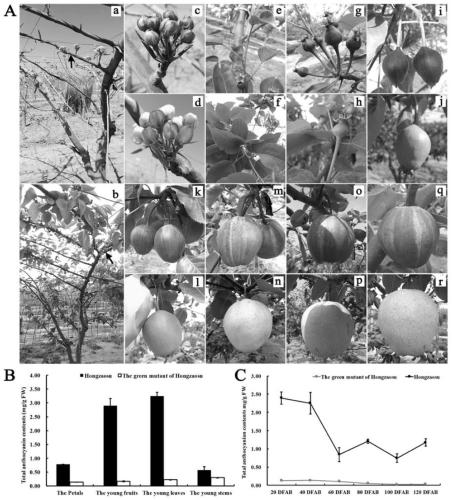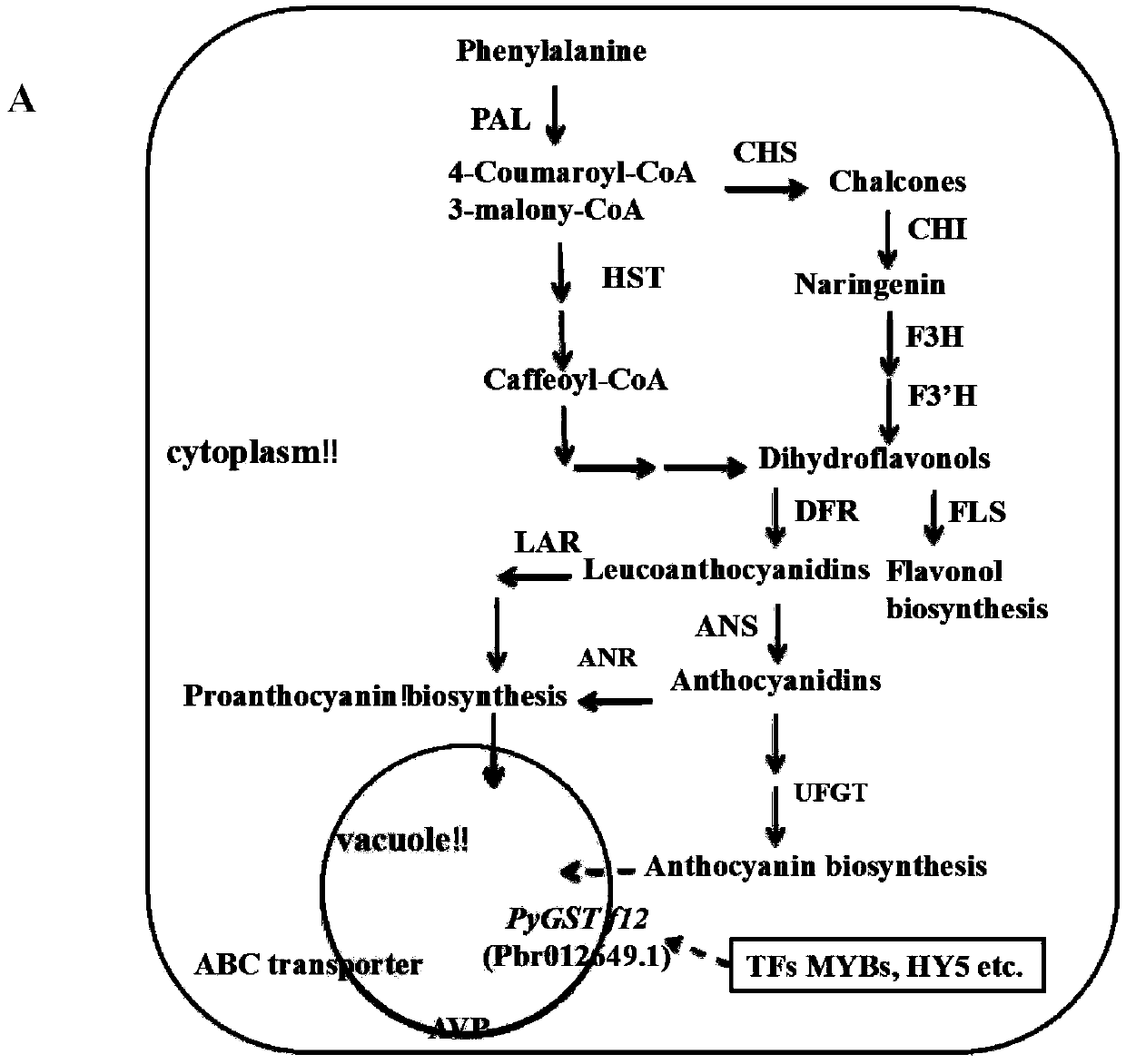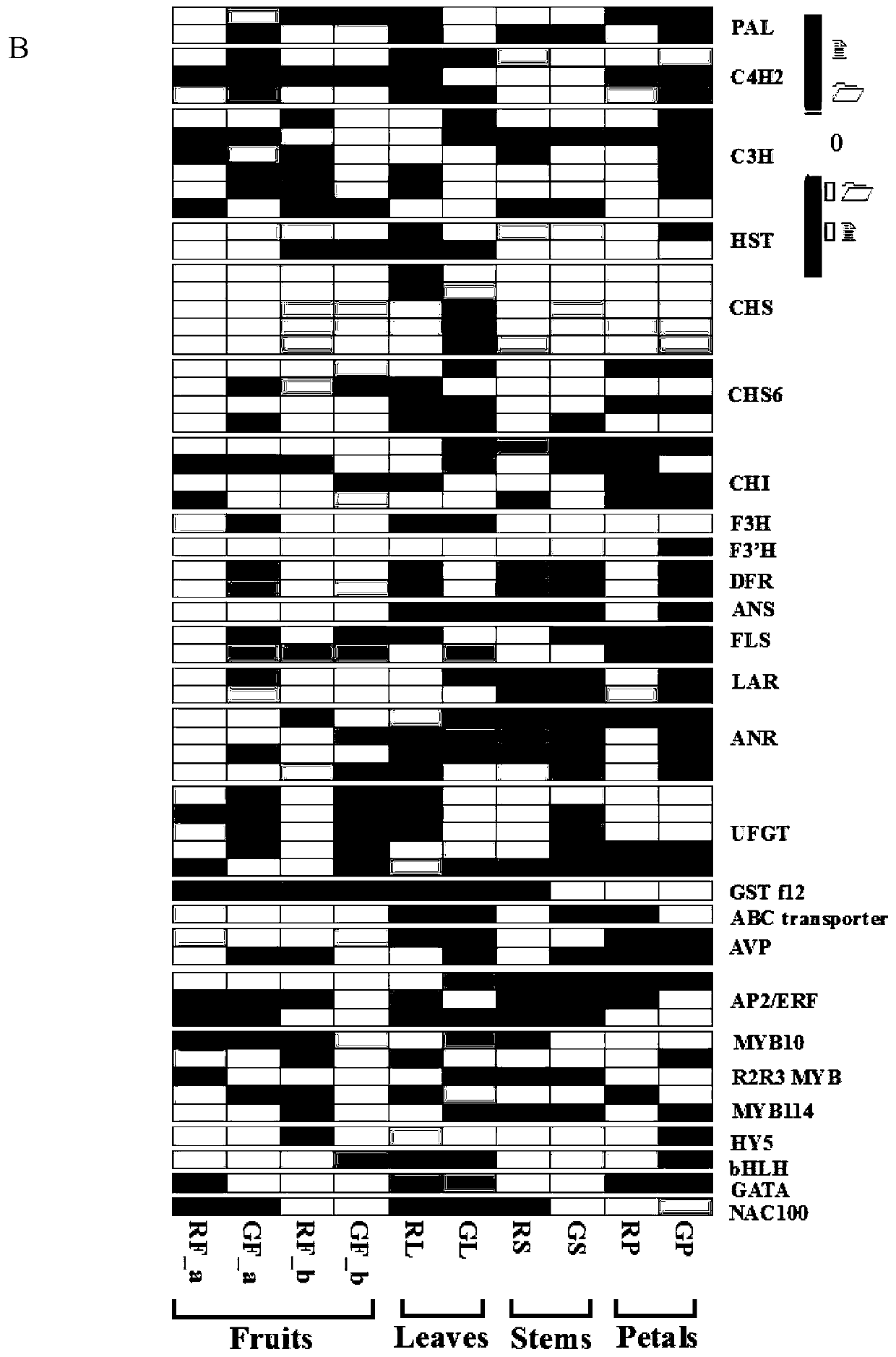PyGSTf12 gene related to transport of anthocyanin in pear fruits, and recombinant expression vector and application of PyGSTf12 gene
An expression vector, anthocyanin technology, applied in application, genetic engineering, plant genetic improvement, etc., to reduce agricultural costs and achieve environmental friendliness
- Summary
- Abstract
- Description
- Claims
- Application Information
AI Technical Summary
Problems solved by technology
Method used
Image
Examples
Embodiment 1
[0033] Example 1 Changes in the content of anthocyanins in different tissues and different development stages of 'Hongzaosu' and its green buds of the present invention
[0034] The total anthocyanin content of 'Hongzaosu' in different tissues was significantly different ( figure 1 B). At 20 days after flowering, the content of ‘Hongzaosu’ in young leaves was 3.26mg.g-1 FW, the young fruit was slightly lower than the leaves, and the petals and young stems were the lowest ( figure 1 B). During fruit development, the total anthocyanin content of 'Hongzaosu' fruit decreased to a relatively low level during the fruit swelling stage (60DAFB) until the fruit ripening stage (120DAFB). In 20DFAB, the highest value is 2.49mg.g-1FW, the lowest value is 0.86mg.g-1FW. The content of anthocyanins in the green mutants of ‘Hongzaosu’ was always low, with only slight changes in different tissues and developmental stages. The total anthocyanin content of the red tissue of 'Hongzaosu' was s...
Embodiment 2
[0035] Example 2 Screening of Differentially Expressed Genes in Four Tissues of Stems, Leaves, Flowers and Fruits of 'Red Zaosu' and Its Green Bud Variation of the Present Invention
[0036] A total of 7650 differentially expressed genes were identified by comparing the red and green tissues of 'Hongzaosu' and its green buds, and there were large differences in differentially expressed genes in different tissues. Among them, a total of 3,708 differentially expressed genes were identified, including 2,101 up-regulated genes and 1,607 down-regulated genes, compared with the green mutant of ‘Hongzaosu’ at 60 days after flowering. The stems of ‘Hongzaosu’ and its green mutant had the least differentially expressed genes (30 up-regulated genes and 10 down-regulated genes). These differentially expressed genes provide a large number of candidate genes related to anthocyanin biosynthesis and transport.
[0037] In addition, we further screened co-differentially non-expressed genes i...
Embodiment 3
[0038] Example 3 The flavonoid metabolic pathway map and the expression pattern heat map and correlation analysis of related genes in 'Hongzaosu' and its green mutants of the present invention.
[0039] The biosynthesis of flavonoids is catalyzed by a series of enzymes and regulated by transcription factors ( figure 2 A). Through RNA-Seq analysis, we identified 60 candidate genes involved in catalysis and regulation ( figure 2 B). Among these genes we found flavanone 3-hydroxylase (FLS, Pbr033501.1) and UDP-glucose:flavonoid-3-O-glucosyltransferase (UFGT, Pbr000426.1, Pbr000427.1, Pbr000428 .1, Pbr001279.1) had higher gene expression levels in red tissues than in green tissues. Notably, the expression level of the UFGT gene Pbr000427.1 was 10-fold higher than that of the gene Pbr000426.1. Since anthocyanin biosynthesis occurs in the cytoplasm, it requires transport to vacuolar storage. The gene Pbr012649.1 encodes glutathione S-transferase, which showed higher expressio...
PUM
| Property | Measurement | Unit |
|---|---|---|
| molecular weight | aaaaa | aaaaa |
Abstract
Description
Claims
Application Information
 Login to View More
Login to View More - R&D
- Intellectual Property
- Life Sciences
- Materials
- Tech Scout
- Unparalleled Data Quality
- Higher Quality Content
- 60% Fewer Hallucinations
Browse by: Latest US Patents, China's latest patents, Technical Efficacy Thesaurus, Application Domain, Technology Topic, Popular Technical Reports.
© 2025 PatSnap. All rights reserved.Legal|Privacy policy|Modern Slavery Act Transparency Statement|Sitemap|About US| Contact US: help@patsnap.com



